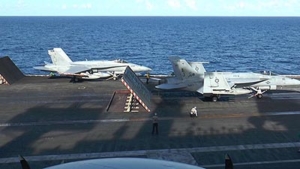Navy-Marine Fighter Fleet In Need of Major Fix

By Debbie Gregory.
The Navy-Marine fighter fleet is in a “death spiral” and the only long-term fix is to buy new jets faster, both F/A-18E/F Super Hornets and the F-35 Joint Strike Fighter.
For many years, the F/A-18 Hornet has been the Navy’s front-line combat jet, taking off from aircraft carriers around the world, enforcing no-fly zones and carrying out strikes.
But more than 60 percent of the Navy’s jets are currently out of service. That number is even worse for the Marine Corps, with some 74 percent of its F-18s not ready for combat operations. Overused, under-maintained, and not replaced, the aircraft are simply wearing out.
The number of planes that are not ready for combat has gotten “very bad,” said one Hill staffer. “If there’s a big war, it’s a serious problem.”
“There will always be a portion of the fleet that will be out of reporting due to mods (modifications), depot maintenance, and other categories, but I think the historical norm is about a third,” said another Hill staff. “Bottom line is the strike fighter situation is bad. I would say very bad.”
The roots of today’s crisis trace back to the 1970s, when the Navy and Marines decided their new F-18 Hornets didn’t need the traditional protections against corrosion. They were wrong.
The next fateful decision came in the 1990s, amidst the post-Cold War drawdown, when the Navy decided to buy fewer of the upgraded F/A-18E/F Super Hornets than planned and the Marine Corps decided not to buy them at all. The post-Cold War peace didn’t last. The demand for aircraft over Iraq and Afghanistan was so intense that the services didn’t give the planes enough time in maintenance depots.
But as the need for maintenance grew, the budget for it got cut — particularly after the Budget Control Act passed in 2011. Decreased funding, personnel cuts, and fewer spare parts have had a tremendous impact on the F-18 fleet’s readiness. If it takes longer to get parts, planes are going to be down longer. If you have fewer mechanics, it takes longer to fix everything.
“Our long-term readiness continues its insidious decline,” Vice Chief of Naval Operations Adm. William Moran testified before the Senate Armed Services Committee. He added, “While we are still able to put our first team on the field, our bench is largely depleted.”
Military Connection salutes and proudly serves veterans and service members in the Army, Navy, Air Force, Marines, Coast Guard, Guard and Reserve, and their families.

















